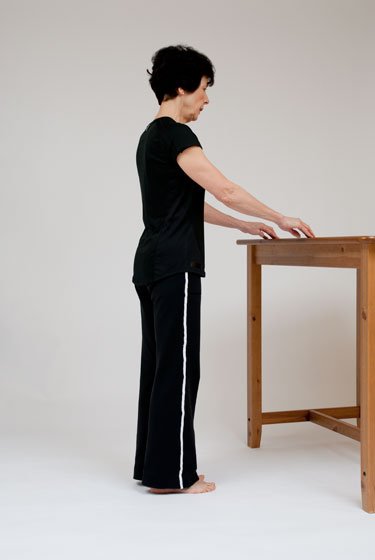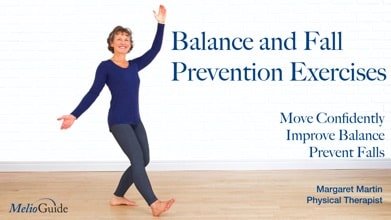Table of Contents
The heel drop exercise is a safe and effective osteoporosis exercise. In today’s post I discuss why the exercise is effective, provide guidelines for people concerned with the impact that the exercise has on bones, demonstrate and describe how to do the heel drop exercise, and suggest a modified, lower impact, version of the heel drop exercise.
You can find the heel drop exercise in the Beginner level section in the Exercise for Better Bones program. The heel drop exercise targets the muscles in your calf. It also targets the bones in your heel, lower leg, upper leg and hip, including your femoral neck.
Does the Heel Drop Exercise Build Bone?
Yes, the heel drop exercise builds bone.
How?
The heel drop exercise generates ground reaction forces which, in turn, create muscle vibration that stimulate bone growth in both the leg and hip area. The vibrations (or stimuli) also occurs when we do weight-bearing activities such as walking briskly or running.
This stimuli, or stress, encourages bone formation that can lead to an increase in bone density.
Recent research (1) comparing the heel drops to other osteoporosis exercises indicates that it is one of the better exercises you can do to increase bone density.
How Effective is the Heel Drop Exercise?
A study published in 2019 (1) examined mechanical loading and muscle activation of four common osteoporosis prevention exercises in early postmenopausal women. The four osteoporosis prevention exercises studied were:
- Countermovement jumps exercise*.
- Box drops exercise (Double Leg Jump Down in Exercise for Better Bones).
- Heel drops exercise.
- The stomping exercise.
The research team measured and compared exercise effectiveness using continuous and intermittent stimulus frequencies on fourteen postmenopausal women. The researchers ranked the four exercises on a wide range of criteria including how well each exercise maintained the bone health of the postmenopausal women.
They concluded that countermovement jumps, box drops, and the heel drops exercise may exceed stomping in maintaining postmenopausal bone health.
* Illinois Basketball Applied Sport Scientist, Drake Berberet defines “a countermovement … as a downward action followed by a reciprocal upward action.”
In other words, you go down into a squat, take a brief pause, and then explode into your upward jump.
Weight Bearing Exercise and Ground Reaction Forces
Several studies by Bassey and Ramsdale (2) (3) indicate that ground reaction forces from weight bearing exercises improve or maintain bone health.
One of the studies (2) showed a “maintenance effect” of bone density in postmenopausal women who were more than six years postmenopausal.
This means that the patient is not losing bone during menopause. Many women lose bone during this stage. I like to to tell my clients “that if you are maintaining, then you are gaining”.
In the book, AstroFit, the authors refers to Bassey’s work. Her research leads her to believe that “heel drops exercise are an easy way to preserve and increase bone mass in premenopausal women.”
The authors recommends that if you are a premenopausal woman, that you perform the 50 repetitions of the heel drop exercise 5 times a day.
Is the Heel Drop Exercise Safe for Individuals with Osteoporosis?
The ground impact from the heel drop exercise causes force to go through the bones in the lower extremities and the hips. A study that measured force transducers in the hip, indicated that the force of the heel drop exercise was approximately three times the body weight.
As a results, clients and readers with osteoporosis have some concerns about the exercise. They want to know if it is a safe exercise for their bones. The next section provides guidelines for individuals concerned with heel drops and bone health, particularly osteoporosis and fracture risk.
Heel Drop Exercise Guidelines for Osteoporosis
Heel drop exercise is one of many of exercises I provide in Exercise for Better Bones.
However, I do not recommend that individuals with acute vertebral fractures do this exercise without consulting with a licensed healthcare professional, such as a Physical Therapist, knowledgeable in the treatment and management of osteoporosis.
How hard you want to drop (and cause impact) depends on your fracture risk. Here are my guidelines by degree of fracture risk:
- Low fracture risk. Free fall onto your heels.
- Moderate fracture risk. Control the impact somewhat and drop moderately hard.
- High fracture risk. Drop gently, unless guided otherwise by your healthcare practitioner.
- You Have a History of compression fracture. Drop gently, unless guided otherwise by your healthcare practitioner.
For those of you in the moderate to high fracture risk, I encourage you to look at the Modified Heel Drops 8 Brocade Exercise video later in this post.
How to Do the Heel Drop Exercise
Carefully follow these instructions to complete the heel drop exercise. Refer to the guidelines listed earlier in this post on how aggressively you should do this exercise.
To complete the heel drop exercise, you literally drop your heels onto the floor.
Staring Position
- Wear flexible shoes or stand barefoot on a soft mat.
- Maintain your best postural alignment.
- Rest your hands on a sturdy support.
- Stand with your feet hip-width apart and pointing forward.
- Keep your knees ever-so-slightly bent, or unlocked.
- Engage your tummy muscles.

Movement
- Inhale as you raise your heels off the floor and transfer your weight evenly onto the balls of your feet.
- Maintain a long spine with your eyes looking forward.
- Exhale, gently tighten your pelvic floor and abdominals as you let yourself drop back onto your heels.
- Repeat until the set is complete.

You Are in Control
Prefer a softer landing? Take control of the descent of your heels.
- Come down gently if you want to get the benefits of strengthening your calf muscles, but without the pounding to the skeleton.
- A controlled heel drop is referred to as a heel raise or heel lift. I will cover this exercise in detail in a later post.
Number of Reps and Sets
In Exercise for Better Bones, I provide a detailed workout plan that recommends the frequency of the heel drop exercise (and other exercises in the program).
Heel Drop Exercise Tips
Here are several important tips to keep in mind when doing this exercise:
- Do not hyperextend your knees. Keep you knees soft.
- If you always wear orthotics you may want to wear them with the exercise.
- In case you have or had plantar fasciitis, start very gradually and consider footwear or a soft surface.
- Do not let your hips move forward or backward.
- Individuals who experience stiffness or pain in their toes can wear running shoes while doing the heel drops.
- Lower your heels gently if you have had a hip or knee replacement.
- Consult a pelvic health physiotherapist before doing this exercise if you experience incontinence or if you have had a prolapse. They will likely prescribe a set of exercises specific to your pelvic health.
- Be sure to regularly massage and stretch your feet and lower legs.
Heel Lift Exercise and Balance
Consider the heel lift exercise if you are concerned about your risk of fracture or health of your joints. The heel lift exercise is the same as the heel drop except you leave out the “drop” part. The heel lift (or raise) exercise can be an important part of a balance and fall prevention exercise program.

Exercise Recommendations for Osteoporosis
Exercise is an essential ingredient to bone health. If you have osteoporosis, therapeutic exercise needs to be part of your osteoporosis treatment program.
But what exercises should you do and which ones should you avoid? What exercises build bone and which ones reduce your chance of a fracture? Is Yoga good for your bones? Who should you trust when it comes to exercises for osteoporosis?
A great resource on exercise and osteoporosis is my free, seven day email course called Exercise Recommendations for Osteoporosis. After you provide your email address, you will receive seven consecutive online educational videos on bone health — one lesson each day. You can look at the videos at anytime and as often as you like.

I cover important topics related to osteoporosis exercise including:
- Can exercise reverse osteoporosis?
- Stop the stoop — how to avoid kyphosis and rounded shoulders.
- Key components of an osteoporosis exercise program.
- Key principles of bone building.
- Exercises you should avoid if you have osteoporosis.
- Yoga and osteoporosis — should you practice yoga if you have osteoporosis?
- Core strength and osteoporosis — why is core strength important if you have osteoporosis?
Enter your email address and I will start you on this free course. I do not SPAM or share your email address (or any information) with third parties. You can unsubscribe from my mail list at any time.
Modified Heel Drop Exercise for Osteoporosis
In the following video I share a study that was done incorporating a modified sequence of the Qigong 8 BROCADE.
Participants performed the modified heel drop three times a day, seven times each time. Over the course of the study — this is really exciting — they were able to gain bone and observe bone mineral density changes improvements in both the spine and the hip.
Find a comfortable spot, a place that feels good for you.
- Place your feet pointing forward, hip width apart.
- Sit back into a mini squat position.
- Relax your arms at your sides.
- For two-minutes bring a gentle smile to your face and let your worries leave your mind. Focus only the positive things in your life.
- Become aware of how your feet are supporting with your weight distributed at the base of your big toe, fifth toe, and the centre for your heel.
- Maintain a nice long alignment through your body.
- Inhale as you bring your arms up, to rise onto the balls of our feet.
- Exhale as you drop your heels and return to the mini squat position.
Modified Heel Drop Tips
Stand beside or in front of a sturdy support until you know you can perform the move with confidence.
If a 2-minute mini squat at the beginning of the sequence is difficult, begin with the amount of time you are comfortable with. Gradually build up your endurance until you reach 2-minutes. You’ll be surprised how quickly you will progress.
Just as with the heel drops mentioned in the beginning of the blog, wear footwear with or with our orthotics if you are accustomed to doing so with all your activities. If you wish to wean yourself from your shoes, it is best to do so under the guidance of your foot care professional or physical therapist.
As with all new exercises, no matter how gentle they appear, it is wise to start slowly and evaluate how your body responds.
You might just start with one or two of these knowing that with time and perseverance you will be able to build up to seven repetitions, three times a day.
Exercise Recommendations for Osteoporosis
Exercise is an essential ingredient to bone health. If you have osteoporosis, therapeutic exercise needs to be part of your osteoporosis treatment program.
But what exercises should you do and which ones should you avoid? What exercises build bone and which ones reduce your chance of a fracture? Is Yoga good for your bones? Who should you trust when it comes to exercises for osteoporosis?
A great resource on exercise and osteoporosis is my free, seven day email course called Exercise Recommendations for Osteoporosis. After you provide your email address, you will receive seven consecutive online educational videos on bone health — one lesson each day. You can look at the videos at anytime and as often as you like.

I cover important topics related to osteoporosis exercise including:
- Can exercise reverse osteoporosis?
- Stop the stoop — how to avoid kyphosis and rounded shoulders.
- Key components of an osteoporosis exercise program.
- Key principles of bone building.
- Exercises you should avoid if you have osteoporosis.
- Yoga and osteoporosis — should you practice yoga if you have osteoporosis?
- Core strength and osteoporosis — why is core strength important if you have osteoporosis?
Enter your email address and I will start you on this free course. I do not SPAM or share your email address (or any information) with third parties. You can unsubscribe from my mail list at any time.
References
- Montgomery G. Et al. The mechanical loading and muscle activation of four common exercises used in osteoporosis prevention for early postmenopausal women. Journal of Electromyography and Kinesiology. Volume 44. February 2019, Pages 124-131
- Bassey J, Ramsdale S. Weight-bearing exercise and ground reaction forces: a 12-month randomized controlled trial of effects on bone mineral density in healthy postmenopausal women. Bone, 1995 Apr;16(4):469-76
- Bassey J, Ramsdale S. Increases in femoral bone density in young women following high impact exercise. Osteoporosis Int, 1994;4:72-75
Osteoporosis Exercise Plan
Visit my Osteoporosis Exercise Plan page for more information on this topic.

Comments